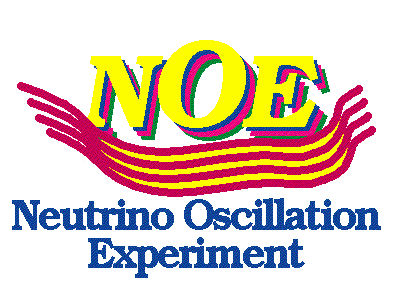

The NOE Collaboration proposed a large
underground electronic experiment composed by alternated modules of TRD,
acting as neutrino target, and scintillating fiber calorimeters.
The detector,
total weight 6.7 ktons, 63 meters long, should be located at the
Gran
Sasso Laboratory, and has been optimized for long baseline neutrino
oscillations studies, in particular to be sensitive in the region of parameters
suggested by the atmospheric neutrino anomaly.
Kinematical tagging of ![]() requires a detector with high performance,
requires a detector with high performance,
while the low neutrino flux at long distance
reflects in the need of large mass detectors. On the other hand the detector
granularity has to match with the cost and the number of read-out channels.
The search for ![]() appearance in the
appearance in the ![]()
![]() e
e ![]()
![]() channel using kinematical criteria, requires a good e/
channel using kinematical criteria, requires a good e/![]() separation to reject the neutral current with
separation to reject the neutral current with ![]() and a good energy and
and a good energy and ![]() resolution (
resolution (![]() ,
, ![]() )
both for electrons and pions, to reject the residual
)
both for electrons and pions, to reject the residual ![]() in the beam. Therefore good calorimetric features are mandatory to obtain
small
in the beam. Therefore good calorimetric features are mandatory to obtain
small ![]() and
and ![]() ,
the latter requiring also a fine segmentation.
,
the latter requiring also a fine segmentation.
A general purpose electronic detector
running deep underground, can also address atmospheric neutrino physics.
For this purpose a good timing resolution is highly advisable, in order
to distinguish neutrino induced upgoing muons from downgoing ones. Such
study would benefit from isotropic detector, running for long periods,
due to the low atmospheric neutrino flux.
A NOE prototype composed by a TRD target and a 4 ton calorimeter module has been tested to the CERN PS T7 beam
INFN and Dip. Scienze Fisiche - Naples Home
Page;
INFN Gran Sasso Laboratories Home
page
Fausto Guarino
E-Mail: Fausto.Guarino@na.infn.it